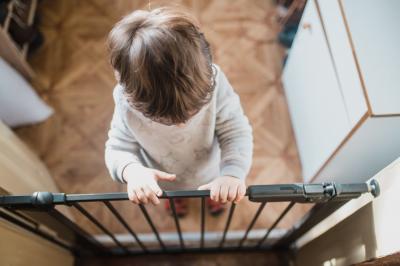A Guide to Babyproofing Your Home

As every parent can attest, babies and curiosity go hand-in-hand. Although a child’s inquisitive nature is a wonderful asset to their development, it can lead to serious injuries if safety precautions are not taken. Accidental injuries are the number one cause of death in children, with firearm injuries now at the top of the list. Furthermore, caregivers can underestimate how skillful these little humans can be at getting into trouble (think, toddler climbing up kitchen counters and getting into the unlocked medicine cabinet, etc). Remember that it is important not to punish a child for being curious, but rather, to take the steps necessary to prevent injuries.
Babyproofing your home can feel overwhelming (as a mom of 3, I feel your pain!). I recommend focusing on one room at a time, and to get started when your baby is about 4-5 months old, giving you a few months to prepare before s/he starts crawling.
Although the following list is not 100% foolproof and does not replace close supervision, it covers the most important things to decrease the risk of injury (this is not an exhaustive list, as every home is unique in its potential hazards). I’ve included links to various products as examples, but most of these items can be found in the baby aisle at stores like Target, Walmart, or online at Amazon, etc.
General/miscellaneous
- Store any firearms unloaded and in a locked device.
- All caregivers should be CPR certified and recertified every 2 years - the American Red Cross has both in-person and virtual options
- Keep all choking hazards out of reach (a choking hazard is anything small enough to pass through a toilet-paper roll - larger than you might think!)
- Keep all magnets and batteries out of reach (these could be fatal if ingested)
- Secure points of entry and exit with locks that your toddler can’t reach
- Install outlet covers if your outlets are not marked as “tamper-resistant”
- Lock all medicine cabinets throughout the home (even adult bedrooms/bathrooms). I use this adhesive option.
- Use door knob covers on doors your child should not open
- Windows can be a fall risk, and screens don’t prevent toddlers from falling out. Apply “wedge locks” like these to prevent the window from opening completely, or window guards (with bars that go inside the window frame). With these devices, an adult can still open the window in an emergency.
Baby’s room
- Less is more in the bassinet/crib - avoid stuffed animals/loose blankets or pillows for babies less than 12 months old, to prevent suffocation
- Install anti-tip furniture anchors to secure heavy/tall furniture to the wall (book shelves, bureaus) - this usually requires drilling
- Use cordless blinds (blinds with cords are a strangulation hazard)
- Use a lidless toy box (heavy lids can be dangerous for little fingers, or worse, the child could climb inside and be trapped if the lid closes)
- Lower the crib to the lowest setting when child starts to sit up, to prevent falls
- Transition child to toddler bed at 18-24 months, before they start to climb out
- I do not generally recommend a breathing monitor during sleep unless indicated by your child’s medical provider
Living room
- Keep TV remotes out of reach (babies can easily open and access the batteries)
- Keep non-skid pads under any loose rugs
- Use a top door chain or lock to keep sliding glass doors closed, like this.
Garage
- Install a top lock on the door that leads to the garage, like this one.
- Make sure poisonous substances like antifreeze are out of reach and that child does not have access to garage without supervision
Bathroom
- Use a bath spout cover to prevent hitting head on metal spout
- Keep water temperature below 120 degrees Fahrenheit
- Anti-slip bath mat in the bathtub
- Install a toilet seat childproof lock to prevent drowning, such as this one.
- Drowning prevention - remember to never leave a child alone in the bath.
Stairway
- Install a strong security gate at top of stairs, and a retractable gait at the bottom (retractable gaits are not strong enough to be used at the top of the stairs). Here is a handy baby gait reference.
- Make sure all stair railings/banisters are secure and not wobbly
- At the top of the stairs, remove any moveable furniture like chairs that a toddler could slide over and use to jump over the gate/banister
Kitchen
- Place safety covers on stove knobs to keep baby from turning it on
- Use rear burners on the stovetop to cook, making it harder for baby to reach up and grab the hot pan
- Keep knives/dangerous kitchen items in drawer with lock/latch
- Place a lock/latch on cabinets that contains dishwasher detergent and other poisonous products, like these or these.
- Keep the poison control number on your fridge - 1-800-222-1222
- Install carbon monoxide and smoke detectors and replace batteries as needed
- Keep a fire extinguisher or fire blanket handy, and make sure all caregivers know how to use it
Outdoors/Driveway
- If you have a sloped driveway with low visibility, place a “children at play” sign in your yard, or a convex traffic mirror for blind spots
- Remove standing water from buckets in the yard to prevent drowning
- Homes with swimming pools must have a fence around them; keep a lock on the top of any sliding doors leading out to the pool
This list may seem daunting, but it’s OK to work on it gradually (and early!). Do a final sweep (even crawl on the floor to visualize your home from your baby’s perspective) to determine your own home’s potential hazards. Get CPR certified and have all caregivers do so. Speak to your pediatrician if you have any questions; we are always happy to talk safety!
